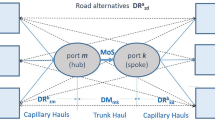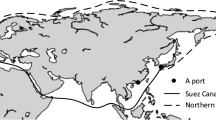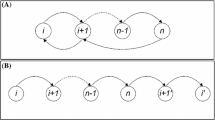Abstract
This article is motivated by growing concerns related to shipping \(\hbox {CO}_{2}\) and \(\hbox {SO}_{\mathrm{x}}\) emissions in the hope that ship operators further consider the environmental impacts of their activities when attempting to maximize profit. The article proposes a liner shipping multi-objective optimization (MOO) model based on profit maximization, \(\hbox {CO}_{2}\) emissions minimization, and \(\hbox {SO}_{\mathrm{x}}\) emissions minimization for which all objective functions are a function of vessel sailing speed. Two demand configurations are considered: elastic and inelastic. The MOO model is solved using three different methods and is applied to two liner services deployed on the trans-Pacific and Europe–Far East markets. A single-objective optimization approach is also proposed in which the monetary value of the emissions is considered in an objective function. The main conclusion of the article is that the sensitivity of demand to transit time is based on the gap between economic and environmental optimal solutions and that policies considering imposing a tax on \(\hbox {CO}_{2}\) or \(\hbox {SO}_{\mathrm{x}}\) to reduce the negative externalities from international shipping should account for this element.


Similar content being viewed by others
Notes
If transportation demand were stochastic with continuous probability distribution, it would be easy to take this into account in the objective function by changing the revenue function into an integration over the possible values of transportation demand up to vessel capacity. However, this would not affect the nature of the objective function, and constraints (7)–(10) would be indirectly included through the integral bounds. Moreover, the same could apply in the case of stochastic demand with a discrete probability distribution.
Hong Kong, Yantian, Kaohsiung, Keelung, Los Angeles, Oakland, Busan, Kwangyang, Keelung, Kaohsiung, Hong Kong
Felixstowe, Hamburg, Rotterdam, Le Havre, Colombo, Taipei, Ningbo, Shanghai, Colombo, Felixstowe
For the trans-Pacific service, when assuming \(\hbox {P}_{\mathrm {CO}_{2}} =\$50/\hbox {ton}\) of \(\hbox {CO}_2\) and \(\hbox {P}_{\mathrm {SO}_\mathrm{x}}=\$121.50/\hbox {ton}\) of \(\hbox {SO}_\mathrm{x}\), the optimal profit for the single-objective model is equal to $673/day. The optimal speed is 11.0 knots with 10 vessels, similar to results when higher values were considered.
References
Alphaliner. (2015). http://www.alphaliner.com. Accessed Jan 2016.
Andersson, H., Fagerholt, K., & Hobbesland, K. (2015). Integrated maritime fleet deployment and speed optimization: Case study from RoRo shipping. Computers & Operations Research, 55, 233–240.
Boros, E., Lei, L., Zhao, Y., & Zhong, H. (2008). Scheduling vessels and container-yard operations with conflicting objectives. Annals of Operations Research, 161, 149–170.
Bouchery, Y., & Fransoo, J. (2015). Cost, carbon emissions and modal shift in intermodal network design decisions. International Journal of Production Economics, 164, 388–399.
Caramia, M., & Dell’Olmo, P. (2008). Multi-objective management in freight logistics: Increasing capacity, service level and safety with optimization algorithms. New York: Springer.
Cariou, P. (2011). Is slow steaming a sustainable means of reducing \(\text{ CO }_{2}\) emissions from container shipping? Transportation Research Part D, 16, 260–264.
Cariou, P., & Cheaitou, A. (2012). The effectiveness of a European speed limit versus an international bunker-levy to reduce \(\text{ CO }_{2}\) emissions from container shipping. Transportation Research Part D, 17(2), 116–123.
Cariou, P., & Cheaitou, A. (2014). Cascading effects, network configurations and optimal transshipment volumes in liner shipping. Maritime Economics & Logistics, 16, 321–342. https://doi.org/10.1057/mel.2014.4..
Cheaitou, A., & Cariou, P. (2012). Liner shipping service optimization with reefer containers capacity: An application to northern Europe–South America trade. Maritime Policy & Management, 39(6), 589–602.
Cheaitou, A., & Cariou, P. (2017). A two-stage maritime supply chain optimization model. International Journal of Shipping and Transport Logistics, 9, 202–233.
Corbett, J., Wang, H., & Winebrake, J. (2009). The effectiveness and costs of speed reductions on emissions from international shipping. Transportation Research Part D, 14, 593–598.
Corbett, J., Winebrake, J. J., Green, E. H., Rasibhatla, P., Eyring, V., & Laue, A. (2007). Mortality from shipping emission: A global assessment. Environmental Science & Technology, 41(24), 8512–8518.
Cridland, C. (2015). Analysis of vessel speeds & port callings. In ISMF annual meeting, Gothenburg. http://www.imsf.info/media/1222/day-2-colin-cridland-port-callings-analysis-imsf-gothenburg-2015-final.pdf. Accessed 30 June 2017.
Dehghani, M., Esmaeilian, M., & Tavakkoli-Moghaddam, R. (2013). Employing fuzzy ANP for green supplier selection and order allocations: A case study. International Journal of Economy, Management and Social Sciences, 2(8), 565–575.
Demir, E., Bektas, T., & Laporte, G. (2014). The bi-objective pollution-routing problem. European Journal of Operational Research, 232, 464–478.
Den Elzen, M., & Höhne, N. (2008). Reductions of greenhouse gas emissions in Annex I and non-Annex I countries for meeting concentration stabilization targets. Climatic Change, 91, 249–274.
Drewry Shipping Consultant. (2016). Container forecaster. London: Drewry Maritime Research.
European Commission. (2003). External costs: Research results on socio-environmental damages due to electricity and transport. https://ec.europa.eu/research/energy/pdf/externe_en.pdf. Accessed 22 June 2017.
European Union. (2011). Roadmap to a single European transport area: Towards a competitive and resource efficient transport system. In European Commission white paper.
Fagerholt, K., Laporte, G., & Norstad, I. (2010). Reducing fuel emissions by optimizing speed on shipping routes. Journal of the Operational Research Society, 61, 523–529.
Fagerholt, K., & Psaraftis, H. N. (2015). On two speed optimization problems for ships that sail in and out of emission control areas. Transportation Research Part D, 39, 56–64.
Guo, Z., Zhang, D., Liu, H., He, Z., & Shi, L. (2016). Green transportation scheduling with pickup time and transport mode selections using a novel multi-objective memetic optimization approach. Transportation Research Part D https://doi.org/10.1016/j.trd.2016.02.003.
IMO. (2014). Third IMO greenhouse gas study. London: International Maritime Organization.
Kim, J.-G., Kim, H.-J., & Lee, P. T.-W. (2013). Optimising containership speed and fleet size under a carbon tax and an emission trading scheme. International Journal of Shipping and Transport Logistics, 5, 571–590.
Kontovas, C. A. (2014). The green ship routing and scheduling problem (GSRSP): A conceptual approach. Transportation Research Part D, 31, 61–69.
Legriel, J., Le Guernic, C., Cotton, S., & Maler, O. (2010). Approximating the pareto front of multi-criteria optimization problems. Lecture Notes in Computer Science, 6015, 69–83.
Li, J., Sun, X., Wang, F., & Wu, D. (2015). Risk integration and optimization of oil-importing maritime system: A multi-objective programming approach. Annals of Operations Research, 234, 57–76.
Lindstad, H., Eskeland, G. S., Psaraftis, H., Sandaas, I., & Strømman, A. H. (2015). Maritime shipping and emissions: A three-layered, damage-based approach. Ocean Engineering, 110, 94–101.
Liotta, G., Stecca, G., & Kaihara, T. (2015). Optimisation of freight flows and sourcing in sustainable production and transportation networks. International Journal of Production Economics, 164, 351–365.
Mansouri, S. A., Lee, H., & Aluko, O. (2015). Multi-objective decision support to enhance environmental sustainability in maritime shipping: A review and future directions. Transportation Research Part E, 78, 3–18.
Mavrotas, G. (2009). Effective implementation of the \(\varepsilon \)-constraint method in multi-objective mathematical programming problems. Applied Mathematics and Computation, 213, 455–465.
Miettinen, K. (1999). Nonlinear multiobjective optimization. Boston: Kluwer Academic Publishers.
Nieuwenhuis, P., Beresford, A., & Choi, A. K.-Y. (2012). Shipping or local production? \(\text{ CO }_{2}\) impact of a strategic decision: An automotive industry case study. International Journal of Production Economics, 140, 138–148.
Norstad, I., Fagerholt, K., & Laporte, G. (2011). Tramp ship routing and scheduling with speed optimization. Transportation Research Part C, 19(5), 853–865.
Notteboom, T. E., & Vernimmen, B. (2009). The effect of high fuel costs on liner service configuration in container shipping. Journal of Transport Geography, 17(5), 325–337.
Psaraftis, H. N. (Ed). (2016). Green transportation logistics: The quest for win-win solutions. Switzerland: Springer International Publishing.
Psaraftis, H. N., & Kontovas, C. A. (2010). Balancing the economic and environmental performance of maritime transportation. Transportation Research Part D, 15, 458–462.
Psaraftis, H. N., & Kontovas, C. A. (2013). Speed models for energy-efficient maritime transportation: A taxonomy and survey. Transportation Research Part C, 26, 331–351.
Ronen, D. (2011). The effect of oil price on containership speed and fleet size. Journal of the Operational Research Society, 62, 211–216.
Sheng, X., Chew, E. P., & Lee, L. H. (2015). (s, S) policy model for liner shipping refueling and sailing speed optimization problem. Transportation Research Part E, 76, 76–92.
Siddiqui, A., & Verma, M. (2015). A bi-objective approach to routing and scheduling maritime transportation of crude oil. Transportation Research Part D, 37, 65–78.
Tai, H.-H., & Lin, D.-Y. (2013). Comparing the unit emissions of daily frequency and slow steaming strategies on trunk route deployment in international container shipping. Transportation Research Part D, 21, 26–31.
Tang, S., Wang, W., Yan, H., & Hao, G. (2015). Low carbon logistics: Reducing shipment frequency to cut carbon emissions. International Journal of Production Economics, 164, 339–350.
UNCTAD. (2016). Review of maritime transportation 2016. In Paper presented at the United Nations conference on trade and development. New York: Author. http://unctad.org/en/PublicationsLibrary/rmt2016_en.pdf. Accessed 02 July 2017.
Veneti, A., Makrygiorgos, A., Konstantopoulos, C., Pantziou, G., & Vetsikas, I. A. (2017). Minimizing the fuel consumption and the risk in maritime transportation: A bi-objective weather routing approach. Computers and Operations Research, 88, 220–236.
Vierth, I., Sowa, V., & Cullinane, K. (2016). An evaluation of external costs in transport scenarios with greater use of shipping: A comparison of rail and sea for Sweden’s east coast container movements. In IAME conference proceedings. Hamburg: Author.
Wang, C., & Chen, J. (2017). Strategies of refueling, sailing speed and ship deployment of containerships in the low-carbon background. Computers & Industrial Engineering, 114, 142–150.
Wang, S., & Meng, Q. (2012). Sailing speed optimization for container ships in a liner shipping network. Transportation Research Part E, 48, 701–714.
Wang, S., & Meng, Q. (2015). Robust bunker management for liner shipping networks. European Journal of Operational Research, 243, 789–797.
Wong, E., Tai, A., Lau, H., & Raman, M. (2015). A utility-based decision support sustainability model in slow steaming maritime operations. Transportation Research Part E, 78, 57–69.
Zhen, L., & Chang, D.-F. (2012). A bi-objective model for robust berth allocation scheduling. Computers & Industrial Engineering, 63, 262–273.
Acknowledgements
This research has been supported by the Social Sciences and Humanities Research Council of Canada (SSHRC) project (N\(^{\circ }\) 895-2017-1003): “Green Shipping: Governance and Innovation for a Sustainable Maritime Supply Chain”.
Author information
Authors and Affiliations
Corresponding author
Rights and permissions
About this article
Cite this article
Cheaitou, A., Cariou, P. Greening of maritime transportation: a multi-objective optimization approach. Ann Oper Res 273, 501–525 (2019). https://doi.org/10.1007/s10479-018-2786-2
Published:
Issue Date:
DOI: https://doi.org/10.1007/s10479-018-2786-2




